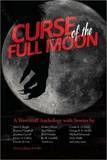 Ulysses Press / June 2010
Ulysses Press / June 2010
Reviewed by: Blu Gilliand
The werewolf is the middle child of the horror genre, stuck between its older, more accomplished sibling the vampire and the younger, brash upstart, the zombie. The werewolf has never had the classic showcase of a Dracula or the popular tidal wave of a Twilight series. Unlike zombies, it’s not enjoying a resurgence thanks to a popular cable series and books by Brian Keene. In fact, most of the success that’s come the werewolf’s way has been of the cinematic kind — think The Howling and The Wolf Man and An American Werewolf in London.
But I’ve always liked a good werewolf story. I see a lot of untapped potential in the character. The idea of transformation, of becoming something new and primal and powerful, is rich earth for authors to mine. So I was excited to crack open editor James Lowder’s Curse of the Full Moon, hoping that some of the high-pedigree writers featured would breathe new life into the character. They did just that, as many of the stories find success by playing around with the traditional rules and conventions of the werewolf character.
For example, the collection kicks off with “My Zoondel,” a Jonathan Carroll story that doesn’t include fangs and fur, but instead is a look at how the beasts within some people stay buried so deeply that their true nature isn’t revealed by physical transformation but instead by bursts of unexplained violence.
Charles de Lint’s “Trading Hearts at the Half Kaffe Café” introduces a slew of new approaches to the classic monster, referred to here as “skinwalkers.” In de Lint’s world of klans and codes of honor, the species is divided into those who wish to live a normal human life and those who “still like to hunt.” These opposing worldviews come to a tense head in de Lint’s tale.
Joe R. Landale can always be counted on to put a unique spin on whatever kind of story he’s writing, and he doesn’t disappoint with “The Gentleman’s Hotel.” The story, a highlight of the collection, melds the werewolf story with Lansdale’s signature take on the Wild West. “Hotel” teams up Lansdale’s Rev. Mercer character with May, a professional girl (ahem) with a colorful vocabulary, and Dol, a ghost who’s already fallen on the bad side of the evil invading the frontier town of Falling Rock. The story moves at a rapid pace and culminates in a blistering finale as werewolves lay siege on the hotel where our heroes are holed up. At one point there are two werewolves, two people, two guns and a horse fighting it out in one hotel room. Great stuff, and a brilliant example of what can be done with the werewolf when a writer really turns loose on the material.
“Lila the Werewolf” by Peter S. Beagle examines the difficulties inherent in dating someone who, every so often, simply loses control. Farrell is a guy whose capacity for acceptance has always suited him well, allowing him to get through situations that would have crumbled others. It’s a trait that comes in handy when he discovers that the new love in his life is, in fact, a werewolf. Unfortunately, even Lila’s full moon transformations can’t keep Farrell interested in the relationship for long, and he finds himself in the difficult position of wanting to break up. With a werewolf.
As with any collection, all is not perfect. The title of Matt Venne’s story – “The Brown Bomber and the Nazi Werewolves of the S.S.” – had me anticipating greatness from the moment I saw it in the table of contents, but unfortunately it’s one of the weak spots in Curse. Venne (who is currently attached to the television adaptation of Stephen King’s Bag of Bones) is going for a pulp feel with this story, but really only captures it in the title. The story sees boxer Joe Louis (The Brown Bomber himself) captured by Nazis and taken to a castle deep behind enemy lines, where he’s forced to fight a German-engineered werewolf in the boxing ring. Looking on from the stands is Louis foe Max Schmeling, who was hoping for a rematch with Louis after suffering an embarrassing defeat at his hands in America. Sounds great, right? Unfortunately, the attempts at humor fall flat, and the climactic fight is anticlimactic, abrupt and disappointingly executed. It’s a shame, because that title is fantastic.
Overall, though, Curse of the Full Moon is a success. Lowder has smartly chosen stories (the majority of which are reprints) that take the werewolf out of the moors and introduce it into a variety of settings and time periods. Silver and moonlight play an integral role in some stories, and are laughed away in others. It all makes for a great mix of moods and approaches that showcase the versatility inherent in one of the classic monsters of the horror genre.
Purchase Curse of the Full Moon edited by James Lowder: